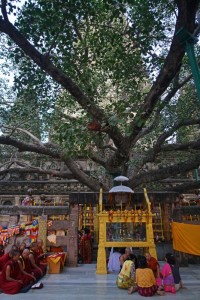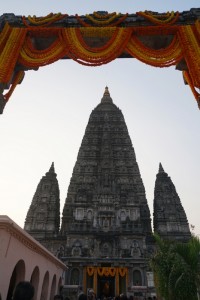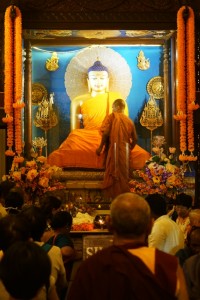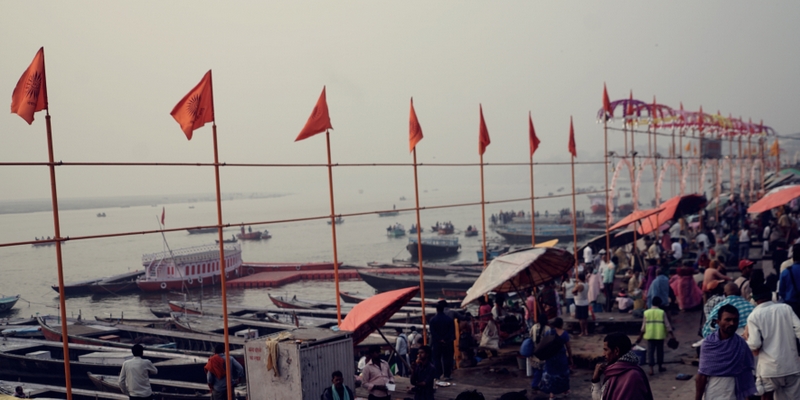Part 1 Pilgrimage from Varanasi to Kathmandu November 10 – 18
Trip Plan
A pilgrimage tour to India to visit sacred sites associated with Buddha has been on my list for years. After the pilgrimage tour to Sri Lanka by the Buddhist Charity last December, I plan to join its pilgrimage trip to India and Nepal from November 10 to 19 this year and go on to Darjeeling and Sikkim afterward. Owing to problem at the Sikkim-China border a few months ago, the travel agent is unable to confirm whether tourists can visit this region. As a result, Bing and Flora who have joined the pilgrimage trip arranged a 15-day historical tour of Madhya Pradesh and Maharashtra (November 19 – December 3) from Delhi to Mumbai. As time is not a problem, I plan to roam in southern India for ten days and return to Hong Kong on December 14.
The Buddha (circa 563 BCE to483 BCE)
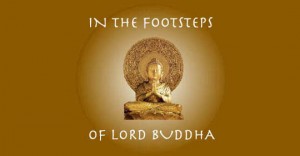 According to the Buddhist tradition, Siddhartha Gautama, the son of Suddhodana who was an elected chief of the Shakya clan, was born in Lumbini in a garden beneath a sal tree. His mother Mayadevi died soon after and he was bought up by his mother’s younger sister. He grew up in Kapilavastu and married Yasodhara and they had a son Rahula. He lived as a prince till he left the palace at the age of 29 in search of life’s ultimate goal. He led a life of a mendicant and first went to Rajagaha, the capital of Magadha, where King Bimbisar offered him his throne. Siddhartha rejected the offer but promised to visit his kingdom first upon enlightenment.
According to the Buddhist tradition, Siddhartha Gautama, the son of Suddhodana who was an elected chief of the Shakya clan, was born in Lumbini in a garden beneath a sal tree. His mother Mayadevi died soon after and he was bought up by his mother’s younger sister. He grew up in Kapilavastu and married Yasodhara and they had a son Rahula. He lived as a prince till he left the palace at the age of 29 in search of life’s ultimate goal. He led a life of a mendicant and first went to Rajagaha, the capital of Magadha, where King Bimbisar offered him his throne. Siddhartha rejected the offer but promised to visit his kingdom first upon enlightenment.
After practicing yogic meditation and yoga under three teachers, he realised meditative dhyana was the right path to awakening but extreme asceticism did not work. He discovered the Middle Way– a path of moderation away from the extremes of self-indulgence and self – mortification or the Noble Eightfold Path which is regarded as the first discourse of the Buddha. After having accepted milk and rice pudding from a village girl Sujata and regained strength, he sat under a pipal tree (Bodhi tree) in Bodhgaya where he vowed never to rise till he had found the truth. After 49 days of meditation, he attained Enlightenment at the age of 35 and became known as the Buddha or “Awakened One”. In brief, Buddha gained insight into the Four Noble Truths, thereby attaining liberation from samara, the endless cycle of rebirth, suffering and dying again.
 After his awakening, he travelled to Sarnath near Varanasi and delivered his first sermon to the five companions with whom he had sought enlightenment. All five became arahants and they formed the first sangha – the company of Buddhist monks.
After his awakening, he travelled to Sarnath near Varanasi and delivered his first sermon to the five companions with whom he had sought enlightenment. All five became arahants and they formed the first sangha – the company of Buddhist monks.
For the remaining 45 years of life, the Buddha travelled in the Gangetic plain to teach. He kept his promise and travelled to Rajagaha to visit King Bimbisara and spent three vassana (raining) seasons at the Bamboo Grove monastery . Two years after awakening, the Buddha returned to Kapilavastu and talked about dharma. During his visit, many members of the royal family joined the sangha including his son Rahula. Five years after the formation of the sangha, Buddha agreed to the ordination of women as nuns.
At the age of 80, Buddha announced he would soon reach Parinirvana, or the final deathless state. After having his last meal offered by Cunda, a blacksmith, Buddha died in Kushinagar. His body was cremated and the relics were divided amongst 8 royal families and his disciples. Centuries later King Ashoka (who reigned from 268 BCE to 232 BCE) enshrined them into 84,000 stupas.
The most important places of pilgrimage in Buddhism are located in the Gangetic plains of northern India and southern Nepal: they are places where the Buddha had lived and taught. The Eight Great Places include four main pilgrimage sites (Bodhgaya, Lumbini, Sarnath and Kushinagar) and four places associated with certain miraculous events (Sravasti, Rajgir, Sankassa and Vaishali). The pilgrimage trip organised by Buddhist Charity would cover the four main pilgrimage sites, Rajgir and Vaishali.
Day 1 November 10 Friday : Hong Kong (GMT+8)– Dehli India (GMT+5.5)
The Buddhist Charity has been organising an annual pilgrimage tour to India and Nepal. This year, 38 participants have signed up. Patrick from the Buddhist Charity is the leader and the logistics are handled by Westminster Travel Ltd. Indian visa can be a hassle. I have been lucky to get an E-visa through Westminster Travel Ltd within two working days without problem at the cost of HK$610 while Bing has paid HK$941 for a manual visa which has taken almost a month!
The group had to meet up at the Hong Kong airport at 10am. I left home early and checked in before 10am. The Jet Airways flight departed on time around noon and we landed at the Delhi airport shortly after 4pm. But the immigration service was inefficient and it was almost 6pm we came out and met our local guide Kunga 貢嘎 at the arrival hall. He has studied Chinese at university and speaks perfect Putonghua.
The most shocking discovery upon arrival is the pollution problem in Delhi. As soon as I stepped out of the plane, I found the toxic smell of the air and the smog unbearable. The traffic was very bad: a short drive to Crowne Plaza Today Gurgaon took half an hour instead of 10-15 minutes. It was my last meal with meat as we would be having vegetable food for the rest of the trip. Cat, my room mate, has a sleeping problem while I sleep soundly when I am tired. Tonight I had a good sleep as the bed was comfortable and the room was quiet.
Day 2 November 11 Saturday: Delhi – Varanasi by air
Today the group would take a domestic flight to Varanasi at 10:50am. We had a wake-up call at 6:30am and left the hotel at 8am. When I was at the check-in counter, the Jet Airways staff took my passport and put my suitcase on the conveyance belt. All of a sudden, he told me to step aside to wait five minutes for the boarding pass. Five minutes turned into an indefinite wait. Patrick was also waiting for his boarding pass. MY gave up his seat to one of the group members. We were told after 10am that the airline had oversold and we were ‘bumped off’. My immediate concern was my luggage which had gone and I had received no luggage tag. Kunga somehow believed my luggage would be flown with the rest of the group luggage. The staff who handled my suitcase at the counter also assured me that my luggage would be taken care. I doubted it!
I wasted my whole day and sadly missed the visit to Sarnath where Buddha gave the first sermon and its museum and to see the Dhamek Stupa, Ashoka Pillar and Mulgandha Kuti Vihar. Instead I spent almost seven hours at the Delhi Airport having more first hand experience about the “Incredible India” in general and its inefficiency in particular. Six passengers (Patrick, MY, a young Chinese lady from the US, a Canadian couple and I) were bumped off. Jet Airways gave each of us 5200 rupees for lunch and tried to put us on a 12:45pm flight on another airline to Varanasi. Around 12:15pm, we were told only three seats were available. As our friends from North America had more pressing needs, we let them take the last three seats and we had to wait for the 3:10pm flight by Jet Airways.
MY tried to call Kunga to find out whether my luggage had arrived with the group without success. Our boarding time was around 2:25pm. Nonetheless, we went to the departure hall which is more spacious after 1pm. The free Wi-Fi service in the airport is not functioning. I therefore went to the lounge with my Priority Pass in order to get online. I headed to Gate 60 at 2pm. It is a long walk.
MY was relieved when he saw me and told me to go to the check-in counter to identify my luggage. I walked as fast as I could. But I was stopped at the security check point: the police said I could not go out and told me to find a Jet Airways staff at Gate 37. When I was at Gate 37, the staff told me to go to Gate 39. By then I realised it was impossible to go out as the gate would be closing soon. The staff told me not to worry as they had called the check-in staff to send the luggage to the plane.
I walked all the way back to Gate 60 and was almost the last passenger to board. Suddenly my anxiety had gone: my instinct told me that my luggage would most unlikely arrive in Varanasi. In the worst scenario I would never find it again. Nonetheless, I would survive though without my camera and computer charger, it would cause inconvenience.
The plane took off on schedule. My fear came true: my luggage was no where in sight in Varanasi. Someone from the local travel agent met us on arrival and took us to Ramada Plaza in Varanasi. As I had nothing with me, I rushed to the shopping mall next to the hotel and spent about 2000 rupees on clothing and 1500 rupees on skin care. It was the second time that I arrived in a destination with my luggage stolen or gone strayed. The first time was when I was hiking in the Sahara Desert in Algeria in 1989. My friends felt sorry for me. But the material loss did not bother me and I remained calm and cheerful. Life goes on and I am a survivor!
Day 3 November 12 Sunday: Varanasi – Bodhgaya (275km)
Varanasi, a city on the River Ganges is a major religious and cultural hub in India. According to legend, Varanasi was founded by Shiva. Over 20,000 temples are estimated to be found in the city. It is the holiest of the seven sacred cities in Hinduism and Jainism and played an important role in the development of Buddhism. The city has at least 84 ghats, most of which are used for bathing by pilgrims and spiritually significant Hindu puja ceremony. Hindus believe that death in the city will bring salvation thus making it a major centre for pilgrimage. The Manikarnika Ghat and Harishchandra Ghat, the last two ghats, are locations where Hindus cremate their dead.
Varanasi has been on my list since my first visit to India in 1978. We got up at 4am and had a morning boat cruise on the river. By the time we arrived at the river bank shortly after 5am, the river bank had already sprung to life: devoted Hindus were performing religious rituals and bathing or swimming in the river. Many women were washing clothes while men spread them out on the steps. Dozens of boat took hundreds of visitors on an hour-long cruise along the river.
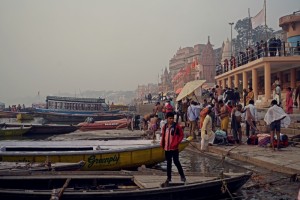 |
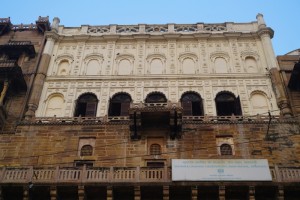 |
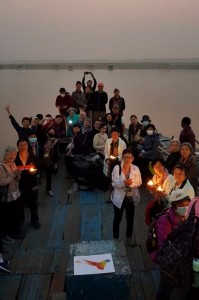 |
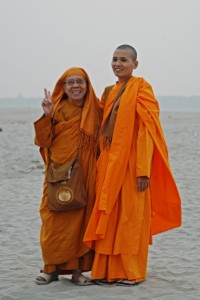 |
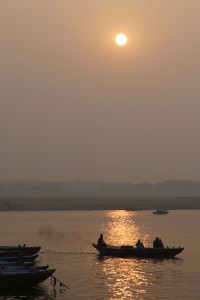 |
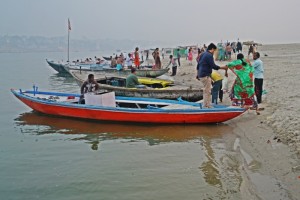 |
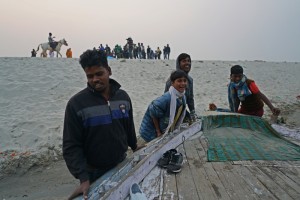 |
Our boat moved slowly along the river bank for a few hundred metres. It was atmospheric to see the ghats dimly lit up. We were dropped off at a sandy island in the middle of the river to watch sunrise. As a result of smog, the sun was not visible until the end of the cruise.
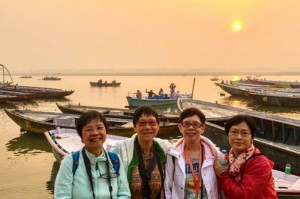 |
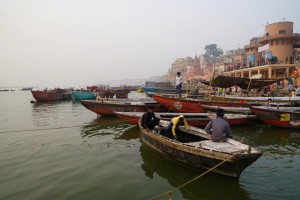 |
Before ending the cruise, our boat man took us to the Manikarnika Ghat and Harishchandra Ghat where large boats carrying wood for cremation purpose were moored. I watched flames going up in two spots. After cremation, the ashes of the deceased would be scattered in the river. There is a lot to see in Varanasi and I love to spend a day or two to explore and understand this spiritual centre. But it is impossible on this pilgrimage trip.
We were back in the hotel for breakfast and set off before 9am for Bodhgaya. The road was generally bad and some sections of the road were half finished. I was sad to see the poor living condition, sub-standard dwellings and the extent of poverty. We took six hours to reach Bodhgaya where we would stay for two nights in Hotel Oaks Bodhgaya. Today, we were joined by a chef who would prepare vegetarian food in Chinese style for us till we reached Lumbini. At 4pm, we departed for the Mahabodhi Temple.
First built by Emperor Ashoka in around 260BCE, the Mahabodhi Temple was built next to the Bodhi tree where Buddha attained Enlightenment after meditating under the tree for 49 days. The tree we see today is 150 years old, a descendant of the Bodhi tree under which Buddha gained enlightenment. Around 250 BCE Buddhist Emperor Ashoka established a monastery and shrine on the holy site after his visit. All the original structures have disappeared except the Diamond throne (built between 250-233 BCE) at the foot of the Bodhi tree.
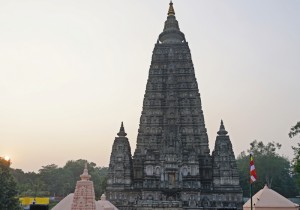 |
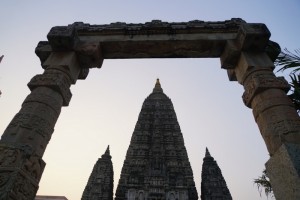 |
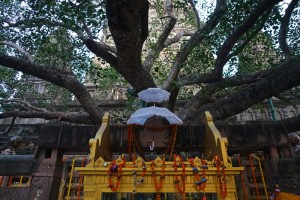 |
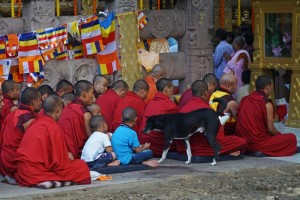 |
The impressive temple complex today includes two large straight-sided shikhara towers built mostly in brick covered with stucco. The largest tower is over 55m high. This is a stylistic feature that has continued in Jain and Hindu temples to the present day and influenced Buddhist architecture in other countries. Sandstone railings with carved panels were built from probably built from the Sunga to the Gupta period (150 BCE to 7th century). Many of the oldest sculptural elements are now placed in the archaeological museum.
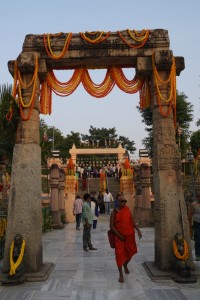 |
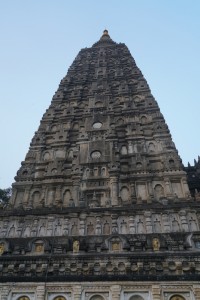 |
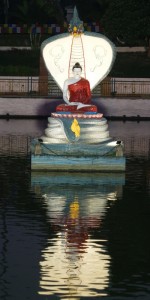 |
According to legend, Buddha spent the succeeding seven weeks at different spots in the vicinity meditating and considering his experience.
First week: under the Bodhi tree.
Second week: Buddha remained standing and stared at the Bodhi tree at a spot which is now marked by the Animeshlocha Stupa.
Third week: Buddha walked back and forth between the Bodhi tree and the location of the Animeshlocha Stupa. Lotus flowers sprung up along this route which is now called Ratnachakrama or the jewel walk.
Fourth week: near Ratnagar Chaityato the north-east side.
Fifth week: Buddha answered in details to queries of Brahmins under the Ajapala Nigodh tree (now marked by a pillar)
Sixth week: next to the lotus pond
Seventh week: under the Rajyatna tree.
Visitors are required to take off their shoes before entering the temple (and the sacred sites). I respectfully lined up in a single file to enter the temple to pay respect to Buddha. Many devoted Buddhists fell on their knees. As there is little room inside, the security guards urged visitors to move on.
Next, we followed our guide walking clockwise. We stood close to the Rajyatna tree (site of the seventh week) looking at the temple complex outside the railing. Then we walked to the back of the temple where the holy Bodhi tree stands (site of first week). Many pilgrims were praying or meditating below or near the tree. We gathered under the tree and cited the Heart Sutra.
We followed the jewel walk (site of the third week) and were back to the entrance to the temple.
On the way out, we stopped at a pillar which marks the site of the fifth week. The guide took us to the lily pond (site of the sixth week). We had an hour’s free time before returning to the hotel at 6:30pm. We strolled leisurely and went to the site where Buddha spent the second week after attaining enlightenment.
As it was Sunday, I saw droves of tourists. Many of them behaved inappropriately and showed no respect for the sacred site. I was impressed by the devoted pilgrims who seemed undisturbed and continued praying or meditating.
My friends and I were glad to have time to stroll around. We walked around and entered the main hall of the temple once more. We found the site of the second week where a temple has been built.


